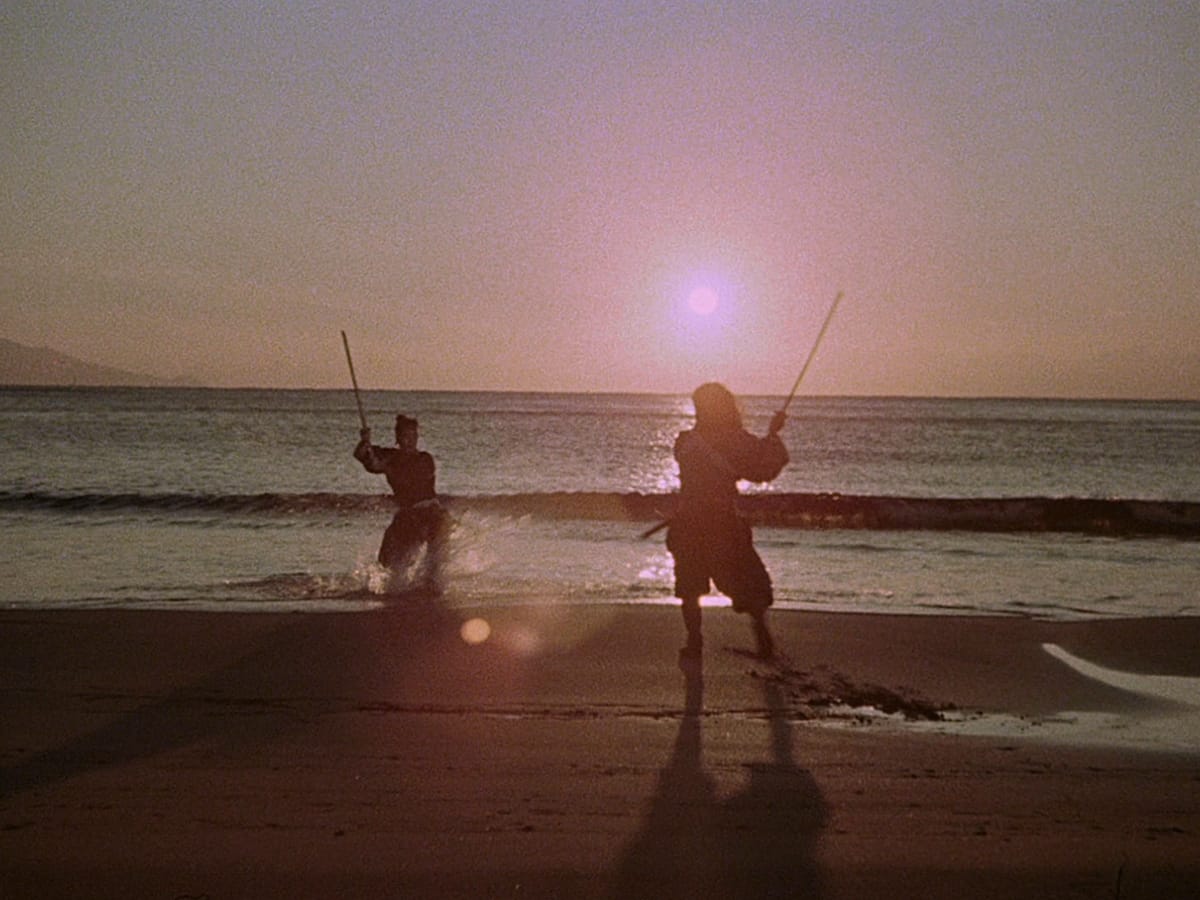The Samurai Trilogy

The Samurai Trilogy, directed by Hiroshi Inagaki and starring the inimitable Toshiro Mifune, was one of Japan’s most successful exports of the 1950s, a rousing, emotionally gripping tale of combat and self-discovery. Based on a novel that’s often called Japan’s Gone with the Wind, this sweeping saga fictionalizes the life of the legendary seventeenth-century swordsman (and writer and artist) Musashi Miyamoto, following him on his path from unruly youth to enlightened warrior. With these three films—1954’s Oscar-winning Musashi Miyamoto, 1955’s Duel at Ichijoji Temple, and 1956’s Duel at Ganryu Island—Inagaki created a passionate epic that’s equal parts tender love story and bloody action.
Films In This Set
-

Samurai I: Musashi Miyamoto
1954
In the first part of the epic Samurai Trilogy, Toshiro Mifune thunders onto the screen as the iconic title character. When we meet him, Miyamoto is a wide-eyed romantic, dreaming of military glory in the civil war that is ravaging the seventeenth-century countryside. Twists of fate, however, turn him into a fugitive. But he is saved by a woman who loves him and a cunning priest who guides him to the samurai path. Though the opening installment of a series, this film, lushly photographed in color, stands on its own, and won an Academy Award for the best foreign-language film of 1955.
-

Samurai II: Duel at Ichijoji Temple
1955
Toshiro Mifune furiously embodies swordsman Musashi Miyamoto as he comes into his own in the action-packed middle section of the Samurai Trilogy. Duel at Ichijoji Temple furthers Miyamoto along his path to spiritual enlightenment, as well as further from the arms of the two women who love him: loyal Otsu (Kaoru Yachigusa) and conniving yet tragic Akemi (Mariko Okada). The film also brings him face to face with hordes of rivals intent on cutting him down, especially his legendary rival Kojiro (Koji Tsuruta). The titular climax is one of Japanese cinema’s most rousingly choreographed conflicts, intensified by Jun Yasumoto’s color cinematography and Ikuma Dan’s triumphant score.
-

Samurai III: Duel at Ganryu Island
1956
A disillusioned Musashi Miyamoto (Toshiro Mifune) has turned his back on the samurai life, becoming a farmer in a remote village, while his nemesis Kojiro (Koji Tsuruta) now works for the shogun. Circumstances bring them back together for one final face-off. Though it’s marked by a memorably intense final battle sequence, the rousing conclusion to the Samurai Trilogy is engaged with matters of the heart as well, as Miyamoto must ask himself what it is that makes a warrior and a man.
Special Features
- New high-definition digital restorations of all three films, with uncompressed monaural soundtracks on the Blu-ray editions
- New interviews with translator and historian William Scott Wilson about the real-life Musashi Miyamoto, the inspiration for the hero of the films
- Trailers
- New English subtitle translations
- PLUS: A booklet featuring new essays by film historian Stephen Prince and Wilson
New cover by Yuko Shimizu
Films In This Set
-

Samurai I: Musashi Miyamoto
1954
In the first part of the epic Samurai Trilogy, Toshiro Mifune thunders onto the screen as the iconic title character. When we meet him, Miyamoto is a wide-eyed romantic, dreaming of military glory in the civil war that is ravaging the seventeenth-century countryside. Twists of fate, however, turn him into a fugitive. But he is saved by a woman who loves him and a cunning priest who guides him to the samurai path. Though the opening installment of a series, this film, lushly photographed in color, stands on its own, and won an Academy Award for the best foreign-language film of 1955.
-

Samurai II: Duel at Ichijoji Temple
1955
Toshiro Mifune furiously embodies swordsman Musashi Miyamoto as he comes into his own in the action-packed middle section of the Samurai Trilogy. Duel at Ichijoji Temple furthers Miyamoto along his path to spiritual enlightenment, as well as further from the arms of the two women who love him: loyal Otsu (Kaoru Yachigusa) and conniving yet tragic Akemi (Mariko Okada). The film also brings him face to face with hordes of rivals intent on cutting him down, especially his legendary rival Kojiro (Koji Tsuruta). The titular climax is one of Japanese cinema’s most rousingly choreographed conflicts, intensified by Jun Yasumoto’s color cinematography and Ikuma Dan’s triumphant score.
-

Samurai III: Duel at Ganryu Island
1956
A disillusioned Musashi Miyamoto (Toshiro Mifune) has turned his back on the samurai life, becoming a farmer in a remote village, while his nemesis Kojiro (Koji Tsuruta) now works for the shogun. Circumstances bring them back together for one final face-off. Though it’s marked by a memorably intense final battle sequence, the rousing conclusion to the Samurai Trilogy is engaged with matters of the heart as well, as Miyamoto must ask himself what it is that makes a warrior and a man.

Special Features
- New high-definition digital restorations of all three films, with uncompressed monaural soundtracks on the Blu-ray editions
- New interviews with translator and historian William Scott Wilson about the real-life Musashi Miyamoto, the inspiration for the hero of the films
- Trailers
- New English subtitle translations
- PLUS: A booklet featuring new essays by film historian Stephen Prince and Wilson
New cover by Yuko Shimizu

Samurai I: Musashi Miyamoto

Samurai II: Duel at Ichijoji Temple

Samurai III: Duel at Ganryu Island